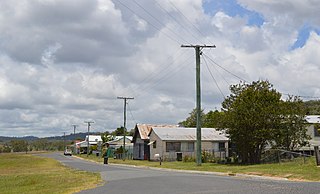
Monto is a rural town and locality in the North Burnett Region, Queensland, Australia. In the 2021 census, the locality of Monto had a population of 1,156 people.

Mulgildie is a rural town and locality in the North Burnett Region, Queensland, Australia. In the 2021 census, the locality of Mulgildie had a population of 147 people.

The Boyne Valley is a rural locality in Gladstone Region, Queensland, Australia. The locality contains four small towns: Nagoorin, Ubobo, Builyan, and Many Peaks. In the 2021 census, Boyne Valley had a population of 301 people.

Didcot is a rural locality in the North Burnett Region, Queensland, Australia. In the 2021 census, Didcot had a population of 85 people.

Humphery is a rural locality in the North Burnett Region, Queensland, Australia. In the 2021 census, Humphery had a population of 24 people.
Cynthia is a rural town and locality in the North Burnett Region, Queensland, Australia. In the 2021 census, the locality of Cynthia had a population of 13 people.

Kalpowar is a town in the North Burnett Region and a locality split between the North Burnett Region and the Bundaberg Region, in Queensland, Australia. In the 2021 census, the locality of Kalpowar had a population of 53 people.

Bancroft is a rural locality in the North Burnett Region, Queensland, Australia. In the 2021 census, Bancroft had a population of 98 people.
Bukali is a rural locality in the North Burnett Region, Queensland, Australia. In the 2021 census, Bukali had a population of 57 people.
Harrami is a rural locality in the North Burnett Region, Queensland, Australia. In the 2021 census, Harrami had a population of 22 people.
Kapaldo is a rural town and locality in the North Burnett Region, Queensland, Australia. In the 2021 census, the locality of Kapaldo had a population of 41 people.
Moonford is a rural town and locality in the North Burnett Region, Queensland, Australia. In the 2021 census, the locality of Moonford had a population of 162 people.
Mount Steadman is a rural locality in the North Burnett Region, Queensland, Australia. In the 2021 census, Mount Steadman had "no people or a very low population".
Riverleigh is a rural locality in the North Burnett Region, Queensland, Australia. In the 2021 census, Riverleigh had a population of 95 people.
Three Moon is a rural locality in the North Burnett Region, Queensland, Australia. In the 2021 census, Three Moon had a population of 178 people.

Mungungo is a rural town and locality in the North Burnett Region, Queensland, Australia. In the 2021 census, the locality of Mungungo had a population of 84 people.

Cania is a locality in the North Burnett Region, Queensland, Australia. In the 2021 census, Cania had a population of 27 people.
Grosvenor is a rural locality in the North Burnett Region, Queensland, Australia. In the 2021 census, Grosvenor had a population of 29 people.

Coominglah is a rural locality in the North Burnett Region, Queensland, Australia. The land use is grazing on native vegetation.
Selene is a rural locality in the North Burnett Region, Queensland, Australia. In the 2021 census, Selene had a population of 27 people.










